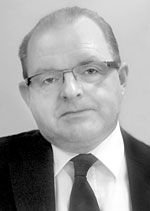The success of Finnish education system draws attention of many countries. Recently Finnish teenagers have been winning first places in mathematics, natural sciences, and reading contests, according to PISA (Programme for International Student Assessment) research of 2006 and 2009. The research is initiated by the Organization for Economic Co-operation and Development and is conducted every three years in the leading industrial countries to check the level of knowledge of 15-year-old teenagers. Finland scored 563 points in 2006, setting a record for the whole period of PISA research. How did the Finns manage to achieve such results? Why do they think in Finland that the children of immigrants should receive basic education in their native language? The Director General of Finnish National Board of Education (Finnish equivalent to Ukrainian Ministry of Education) Aulis Pitkälä and Head of International Relations Kristina VOLMARI gave answers to these questions in a special interview to The Day. This board develops curricula for basic, middle, and vocational education, and now it is getting ready for the launch of a new education program in 2014.
Aulis Pitkälä: “The main key to our success is that our schools are similar for the most part. On the other hand, the profession of a teacher is very popular and respected. That is why we have very good teachers. This may seem a bit strange, but our system does not have standard exams. Our students take their first exam at the age of 19, when they leave school. City councils and schools take care of the development of education. Besides, we are trying to satisfy all the needs our students have, so nobody is left out, everyone is paid attention to. This explains the high average level of education. We want to create one educational community, so everyone can have the same vision of the situation and work together.”
Kristina VOLMARI: “Of course, teacher’s salary plays an important role. It is a bit higher than the average salary in the country. It is partially explained by the fact that a lot of teachers are of senior age, so they receive the seniority pay. In 2009 an average salary in Finland was 2,900 euros. And for teachers of English, for example, it goes up to 3,500 euros.
“Besides, one of the reasons of the popularity of this job is its autonomy. Most of the important decisions that need to be made as soon as possible are taken at the local level. Basically, teachers are involved in making these decisions, and are sort of entrepreneurs at schools. They do not have to obey the orders from above.”
Where does money for teachers’ salaries come from?
A.P.: “City councils pay teachers in most cases. The government also gives money for education. Students do not have to pay for studying at school, all the expenses are covered by taxes.”
How did you manage to reach a consensus that education, including higher education, has to be free?
K.V.: “This consensus was reached a long time ago. Finland was poor, and well-educated people make a really good support for the country. Education in Finland still remains one of the social lifts. We had a long history of national schools education, starting from the times when Finland was part of Russia. Back then we could create national schools. It was not obligatory. It is not true that people were motivated to learn how to read by some nationalist reasons. It was propaganda.”
A.P.: “People who have higher education and high level of culture are respected very much in our country. During the Middle Ages the ability to read was a kind of a test for a citizen. Church promoted reading back then. In 1800’s municipal schools were established, and in 1920 receiving education at school became obligatory for everyone. Another cornerstone of Finnish education and administration system is that we believe in evolution, rather than in revolution. We all believe that education is the highest priority. And we want to reach a consensus, whatever the matter be. When our government changes, we may only experience the slightest changes in the policy. And it is very different for many other countries, where everything starts from the scratch after the government is changed.”
Presidential candidate Sauli Niinist , who had a meeting with foreign journalists, said that there are going to be debates about the cutback in social programs in parliament. Is this going to influence education in any way?
A.P.: “I think MPs will try their best to avoid cuts in the education and health protection budget. But nevertheless, there will surely be some curtailments, although education is the best-protected area in our political system. This protection is guaranteed by special legislation, which in fact guarantees everyone access to basic education.”
The world is becoming more and more globalized. What challenges does this create for Finland’s education system, given that education and innovations are the main moving forces for the economy development?
A.P.: “In a year early education of children from 2 to 5 years old will become part of the Board of Education’s agenda. So, pre-school and elementary education of children from 6 to 7 years old is going to become part of the school system of education. It is too early to say which changes this is going to bring. Perhaps, the quantity of physical education or art class hours will be increased. We are not only going to add academic disciplines, we are also thinking about making improvements in the foreign language teaching system. English is the most popular foreign language in our country. We need teachers of German, French, Russian, and also Chinese.
“The base of our education system is quite versatile and stable at the same time. Therefore, some evolutionary changes may happen, but not the fundamental ones.”
K.V.: “There is a lot of space for adapting some conditions on local level. Our goal is to create a universal national curriculum. And the local school will be able to include some specific courses based on the focus the school wishes to possess.
“We hope that the new curriculum will be focused on innovation, creativeness and entrepreneurship. For the last three years we have been trying to integrate entrepreneurship as a kind of professional studies. I think that the challenge for our schools is the use of information systems and technologies. Some schools already have it, and some still do not. That is why this is a challenge for our education. We do not have any problems with technical supplies, personal computers. We have plenty of those, but we have not just yet managed to integrate it all into the study process.”
How deeply is history studied in Finland?
A.P.: “We have had a lot of debate about this. But we give more attention to the history of Finland. The history of other countries is taught at schools, because without it you will not be able to understand the world. Teaching history starts from grade five. In the ninth grade, students learn social science. Speaking of which, we are not as successful with the progress in history and social science as we would like to be.”
Could you tell what teaching methods are basically used in your country?
A.P.: “We are trying to compile a curriculum based on constructive studies rather than on conduct. That is, we emphasize the methods of learning rather than those of teaching. Key words in this system are studying and learning. A student can have their own individual curriculum and choose optional courses, which are not part of the basic education. This can help in learning. We also use the class as a component in learning. But we give more attention to education based on learning methods and personalization. And if a student has special needs, they indeed get a more personalized curriculum.”
K.V.: “We really want to maximize each student’s potential starting as early as at pre-school stage and middle school.”
How does school respond to the needs of society and business?
A.P.: “Everyone is entitled to basic education. After that, everyone can choose if they want to go to high school [highest level of secondary education. – Ed.] or get a vocational training. Nowadays 50 percent of school students opt for high school, and 50 for vocational training. Over the last 10 years, vocational training has become increasingly popular. The thing is that after three years of training one can get a job, and a very well-paid at that. At the same time, after completing a course of vocational training, one can continue one’s studies at a university.”
K.V.: “The media are very much in favor of professional training. There are a lot of TV programs featuring carpenters or chefs. When I was young, doctors and lawyers were the most prestigious professions. All this influences people’s mentality.”
A.P.: “Right, society needs not only doctors and lawyers, we also need people who make things.”
K.V.: “And we are trying to avoid duplicating education. We are a small country, and we cannot afford re-training people. People at 16 or 18 do not always know what they want to be. Therefore, they often opt for high school. But after getting the certificate of secondary education, not everyone has a possibility to get to the university, since universities have quotas limiting the numbers of applicants. Thus those left out have to get a vocational training. And we want to eliminate the multiplication of education and thus try to orient students at going directly into vocational training.”










